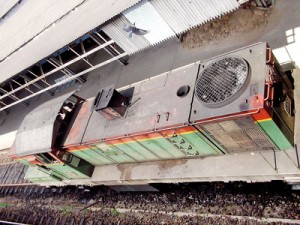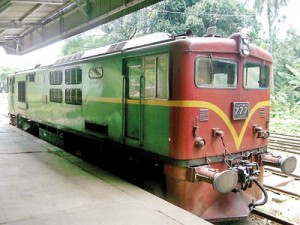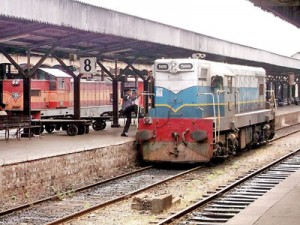The ties that bind: State of the railways…
View(s):Yesterday the Sri Lanka Railway (SLR) passed a milestone: 150 years of operations (though technically, founded in 1858). It was on December 27, 1864 that SLR’s first passenger train ran, 54 kilometres from Colombo Fort to Ambepussa, the then terminus on the main line. As

An old workhorse Class W1 Henschel has a work-a-day shunting at the Colombo Fort Railway Station
administrators and aficionados alike commemorated the event a century and a half later, it was a “green-light, red light” sort of feeling that lingered – like some half-seen signal on a  misty day along the upcountry run.
misty day along the upcountry run.
We looked back… and there was a sense that a glory had passed from the earth: The golden era of steam, British bureaucracy at its best, strengthened by a largely Burgher railway community, the colourful backbone of a then-efficient service.
We looked around – and there were mixed signals: Growth, accelerated development, no small progress now in some quarters such as line extension and restoration; a lot left undone in many other fields like repairs and maintenance of locomotives and rolling stock.
We looked ahead — and the line lay long and clear ahead – if only the 10-year Railway Development Strategy would have the visionary eyes to see “the wonders of the world and all the splendours that could be” (with apologies to Tennyson).
Looking back

A Class M5 Hitachi at Matale Railway Station
A loving glance at the rich history of SLR was a good thing, and a shot in the arm for railway folks all-round (staff, rail fans, tourists and travel enthusiasts). In memory of its notching up 150 years, and no doubt driven and engineered by a few locomotive enthusiasts in the service, SLR had restored a few of the many machines that once hauled passengers and freight along the railway’s 1,508 kilometres of track. These precious locomotives gleamed in the Kadugannawa sun and glistened in even the Kandyan rain – a token, a symbol, an offering of hope… that the glory can and must return; or at least be remembered in museum style, if not fully restored to mundane service.
There were, among these legends of yesteryear, a Class E1 Dübs steamer (No. 93); a class M1 Brush locomotive (No. 560, a champion engine from the B. D. Rampala era: 1955–1970); the first diesel locomotive, No. 500; the ‘power-set’ of a DMU from MAN of Germany, No. 613; and a Class N2 Kawasaki narrow-gauge loco, No. 732. These, in addition to assorted wagons, bogeys, trolleys, rolling stock; all lovingly refurbished and sporting sometimes original, sometimes innovative, and perhaps out-of-place, livery.
Looking around
Today, the track runs true north – and south – and our friends and neighbours, India and China, have invested (or contributed, with “interest” – pun intended) to the improvement of both lines and locos. Cynics might scoff at the Class S9, 10, 12 Chinese-built DMUs that populate virtually every run these days… even the Badulla line… once the domain of the doughty W and M class diesel-electrics, dismissing these as arriviste parvenus. (Who can forget the mystical, magical, “horns of elfland, lightly ringing” as the legendary M1s rendered yeoman service on steep 1:44 gradients? Nos. 626 Montreal and 627 Vancouver, until recently, and even now in fits and starts, still haul their trains up and down…) Sceptics might also pooh-pooh the smoke-laden performance of the more powerful Indian M8s and M10s, their Alco engines leaving an unmistakable

A Class M2 GM-EMD loco swaps duty turns with an M6 at Colombo Fort
and unwelcome trail of exhaust fumes from Jaffna to Matara. But few can deny that the government – even belatedly – has taken an “interest” (no pun intended) in reconnecting once-separated parts of country, with high-speed tracks where “romantically”-named trains such as ‘Yal Devi’ (Queen of Jaffna) and ‘Rajarata Rejina’ (Queen of the Kings’ Country) regularly clock 100kmph.
The state, condition, and degree of the stations in-between cannot be commented on in isolation, varying as they do from hygienic and clinical, to dusty and dirty and grimy; or worse. But for the most part, my impression has been that those 14,400 or so employees who “man” (I have yet to see a single woman stationmaster, for e.g.) the rails, stations, cabins, and services do so with a dedication, commitment, and joie de vivre that is singularly lacking in many other state-run establishments. Of course, this impression is somewhat compromised when the plethora of railway unions strike – often at the drop of a signal, almost always levered by demands for pay revisions – and inconvenience most if not all of the unnumbered-thousand commuters who use SLR daily; for work, school, business, leisure, pleasure. Then there are the sporadic incidents of egregious carelessness or negligence, where ‘irresistible’ trains collide with wayward vehicles or wild animals who think they are ‘immoveable’. My estimation is that we can never be proud enough of our national railway until and unless ALL of its unguarded crossings are secured AND suitable systems are put in place to ensure the safety of passengers AND pachyderms alike.
Looking ahead
In a nutshell, here are the prospects for SLR in a splinter of my mind’s eye:
The future of SLR would be brighter if the state took steps to identify and eliminate waste, corruption and inefficiency in admin, ops, logistics, in a key passenger-transport service that has not made a profit since the mid-1940s: The WWII era. (Revenue is an estimated Rs. 3-4 billion: LBO, 2007/2012; requiring an annual government subsidy of Rs. 7.5 billion. Less than five years ago, its transport-sector market share had slumped to less than ten percent, because of delays, inefficient service, lack of amenities.)
The future of SLR should be bleaker if development of ‘hard infrastructure’ such as extensions of lines took place apace, but at the expense of ‘soft infrastructure’ like cleaner stations and hygienic facilities on board short- as well as long-haul trains and sustainable value added services (e.g. 1st-class sleepers, 1st-class observation cars, 1st-class air-conditioned carriages on intercity and other main lines).
The future of SLR could be better if, while exploring modern railway trends along the lines of metropolitan ring railways and elevated rapid transit for suburban lines, the existing infrastructure was updated and maintained in a manner as to optimise both passenger and freight haulage in this age of congested roads and lack of access to remoter parts of the periphery; AND electrification was considered a serious viability in an emerging eco-friendly rail age.
[These are the observations of an AMATEUR railway enthusiast – in every sense of the word... not “professionally qualified”, but “passionately engaged” with the last vestiges of a fast-dwindling national asset; which, if not protected and developed, could lead track and tie and travel-destination to rack and ruin. Experts may disagree with the diagnosis; but hopefully – if they are right – timely action will be taken to arrest and reverse the rot that seems to be setting in.]


